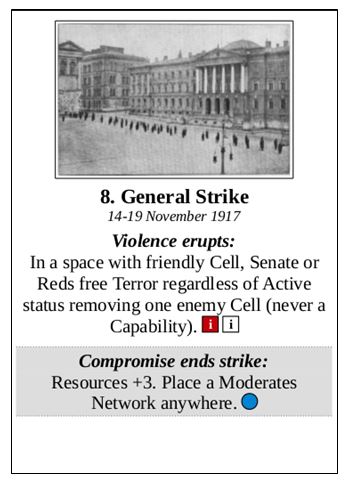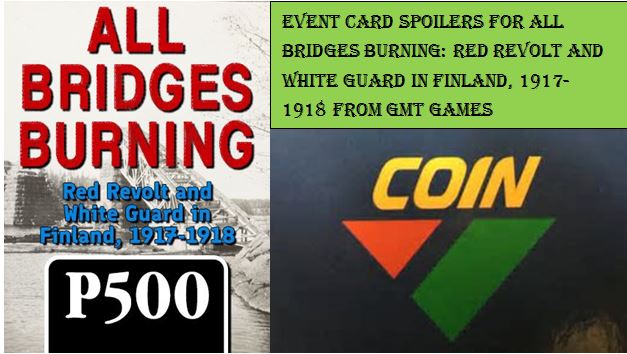In our 2nd Event Card Spoiler post regarding All Bridges Burning: Red Revolt and White Guard in Finland, 1917-1918 from GMT Games, we take a look at card #8 General Strike. Please keep in mind that the artwork and layout of these cards is not yet finalized and is only for playtest purposes at this point.
 8. General Strike
8. General Strike
The card image is one of the most striking photos of the conflict. It shows armed Red Guards – the organized working class militia – standing guard surrounding the Senate building in Helsinki during the general strike of November 1917.
The general strike was a watershed moment in the run-up to the civil war that started in January 1918. The strike was organized by the working class movement and their Red Guards. It demonstrated their ability to bring the country to a stand still and under effective working class control. It was a watershed moment also in that it kickstarted the bourgeoisie preparations for an open conflict with the working class: the general strike illustrated the lead the Reds had over the Whites in their ability to mobilize their respective supporters.
The shaded part of the event is useful to the non-violent Moderates faction in the game. It simulates the hypothetical scenario in which the violence and open hostility stimulates the Moderates’ reconciliatory efforts. After all, during the five days of the general strike several people died in violence across the country. Note that also the Senate or the Reds could choose to become a part of a negotiated solution to the strike, play the shaded part, and garner some resources for it – in All Bridges Burning, resources represent political capital and political will as much as they represent resources in a more material sense.
Highlighting one of the key dilemmas the game poses to the player, in most circumstances the Reds and the Senate players will be sorely tempted to play the unshaded part of the event rather than its much more benign shaded part, yet playing the unshaded part has consequences later on in the game. The unshaded part affords free Terror regardless of whether the faction has already managed to activate its own cell in a space. The event is thus a short cut to something that can be used to remove enemies in a space as well as to make enemy’s attempts at bringing more of their forces into that space more costly – in All Bridges Burning, Terror is somewhat akin to how the Ambush Special Activity has worked in many of the previous COIN Series volumes. At the same time, however, Terror increases Polarization – a measure of mutual hostility between the warring factions – which is something that might come to haunt the players later in the game.
Finally, in case you are wondering, the blue, white, and red symbols on the card are made use of in the non-player solitaire system.

Next card up in the series will be #9 Declaration of Finnish Independence.
In case you missed our 1st spoiled card, you can read about it here: #3 November Revolution in Russia. We would like to thank Vez for his hard work on this game and for providing us this look inside some of the varied Event Cards. If you are interested in All Bridges Burning: Red Revolt and White Guard in Finland, 1917-1918, you can pre-order a copy at the following link: https://www.gmtgames.com/p-675-all-bridges-burning-red-revolt-and-white-guard-in-finland-1917-1918.aspx
-Grant
